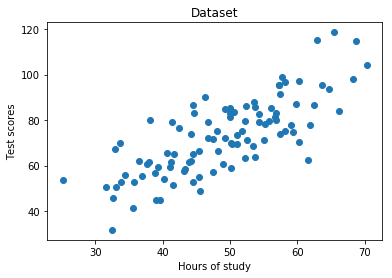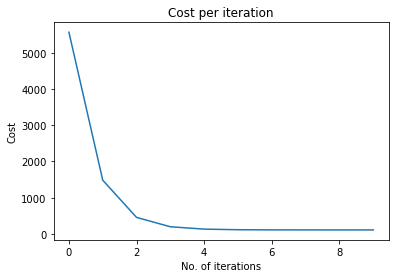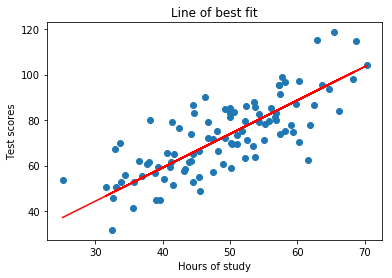The goal of this project was to build a linear regression model from the ground up using numpy.
%matplotlib inline
#imports
from numpy import *
import matplotlib.pyplot as pltHere, we're using a dataset with two columns containing the amount of hours studied and the test scores students achieved, respectively.
points = genfromtxt('data.csv', delimiter=',')
#Extract columns
x = array(points[:,0])
y = array(points[:,1])
#Plot the dataset
plt.scatter(x,y)
plt.xlabel('Hours of study')
plt.ylabel('Test scores')
plt.title('Dataset')
plt.show()#hyperparameters
learning_rate = 0.0001
initial_b = 0
initial_m = 0
num_iterations = 10def compute_cost(b, m, points):
total_cost = 0
N = float(len(points))
#Compute sum of squared errors
for i in range(0, len(points)):
x = points[i, 0]
y = points[i, 1]
total_cost += (y - (m * x + b)) ** 2
#Return average of squared error
return total_cost/Ndef gradient_descent_runner(points, starting_b, starting_m, learning_rate, num_iterations):
b = starting_b
m = starting_m
cost_graph = []
#For every iteration, optimize b, m and compute its cost
for i in range(num_iterations):
cost_graph.append(compute_cost(b, m, points))
b, m = step_gradient(b, m, array(points), learning_rate)
return [b, m, cost_graph]
def step_gradient(b_current, m_current, points, learning_rate):
m_gradient = 0
b_gradient = 0
N = float(len(points))
#Calculate Gradient
for i in range(0, len(points)):
x = points[i, 0]
y = points[i, 1]
m_gradient += - (2/N) * x * (y - (m_current * x + b_current))
b_gradient += - (2/N) * (y - (m_current * x + b_current))
#Update current m and b
m_updated = m_current - learning_rate * m_gradient
b_updated = b_current - learning_rate * b_gradient
#Return updated parameters
return b_updated, m_updatedb, m, cost_graph = gradient_descent_runner(points, initial_b, initial_m, learning_rate, num_iterations)
#Print optimized parameters
print ('Optimized b:', b)
print ('Optimized m:', m)
#Print error with optimized parameters
print ('Minimized cost:', compute_cost(b, m, points))Optimized b: 0.0296393478747
Optimized m: 1.47741737555
Minimized cost: 112.655851815
plt.plot(cost_graph)
plt.xlabel('No. of iterations')
plt.ylabel('Cost')
plt.title('Cost per iteration')
plt.show()Gradient descent converges to local minimum after 5 iterations
#Plot dataset
plt.scatter(x, y)
#Predict y values
pred = m * x + b
#Plot predictions as line of best fit
plt.plot(x, pred, c='r')
plt.xlabel('Hours of study')
plt.ylabel('Test scores')
plt.title('Line of best fit')
plt.show()

